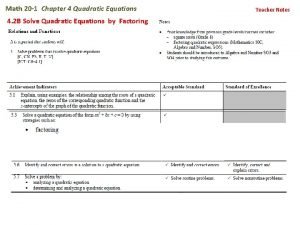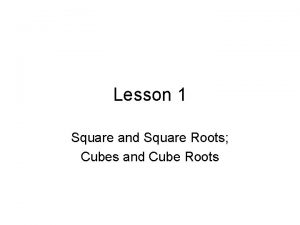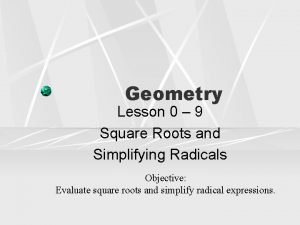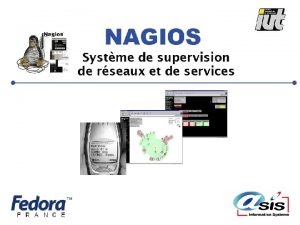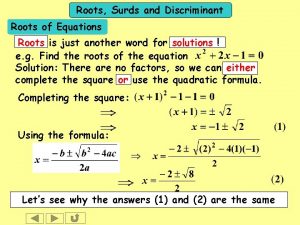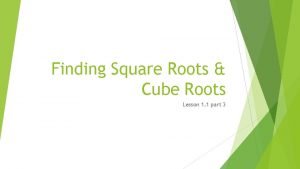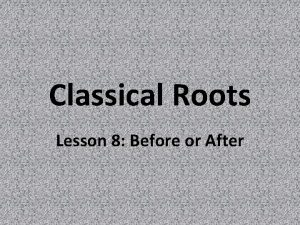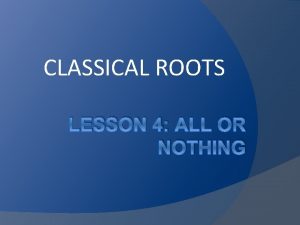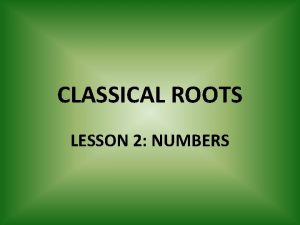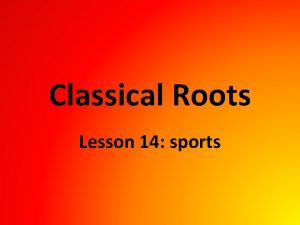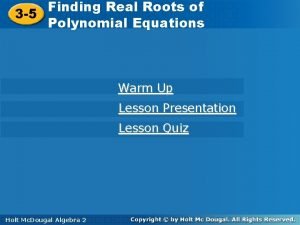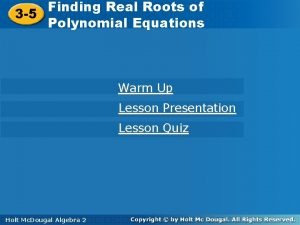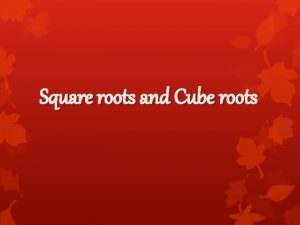Lesson Overview 23 2 Roots Lesson Overview Roots



























- Slides: 27

Lesson Overview 23. 2 Roots

Lesson Overview Roots THINK ABOUT IT Can you guess how large a typical plant’s root system is? A study of a single rye plant showed that the length of all the branches in its root system was an astonishing 663 kilometers (412 miles). The surface area of these roots was more than 600 square meters— 130 times greater than the combined areas of its stems and leaves!

Lesson Overview Roots Root Structure and Growth What are the main tissues in a mature root?

Lesson Overview Roots Root Structure and Growth What are the main tissues in a mature root? A mature root has an outside layer, called the epidermis, and also contains vascular tissue and a large area of ground tissue.

Lesson Overview Roots Root Structure and Growth As soon as a seed begins to sprout, it puts out its first root to draw water and nutrients from the soil. Rapid cell growth pushes the tips of the growing roots into the soil. The new roots provide raw materials for the developing stems and leaves before they emerge from the soil.

Lesson Overview Roots Types of Root Systems The two main types of root systems are taproot systems and fibrous root systems. Taproot systems are found mainly in dicots. Dandelions have a taproot system. Fibrous root systems are found mainly in monocots. Grasses have a fibrous root system.

Lesson Overview Roots Taproot System In some plants, the primary root grows long and thick and gives rise to smaller branch roots. The large primary root is called a taproot. The taproots of oak and hickory trees grow so long that they can reach water several meters below the surface. For example, a dandelion has a short, thick taproot that stores sugars and starches.

Lesson Overview Roots Fibrous Root System In other plants, such as grass, the system begins with one primary root. But it is soon replaced by many equally sized branch roots that grow separately from the base of the stem. The extensive fibrous root systems produced by many plants help prevent topsoil from being washed away by heavy rain.

Lesson Overview Roots Anatomy of a Root As seen in the figure, a mature root has an outside layer of dermal tissue, called the epidermis, and also contains vascular tissue and a large area of ground tissue. The root system plays a key role in water and mineral transport.

Lesson Overview Roots Dermal Tissue: Epidermis The root’s epidermis performs the dual functions of protection and absorption. Its surface is covered with thin cellular projections called root hairs, which penetrate the spaces between soil particles and produce a large surface area that allows water and minerals to enter.

Lesson Overview Roots Ground Tissue Just inside the epidermis is a region of ground tissue called the cortex. Water and minerals move through the cortex from the epidermis toward the center of the root. The cortex also stores the products of photosynthesis, such as starch.

Lesson Overview Roots Ground Tissue A layer of ground tissue known as the endodermis completely encloses the vascular cylinder. The endodermis plays an essential role in the movement of water and minerals into the center of the root

Lesson Overview Roots Vascular Tissue At the center of the root, the xylem and phloem together make up a region called the vascular cylinder. Dicot roots like the one shown in the figure have a central column of xylem cells.

Lesson Overview Roots Apical Meristem Roots grow in length when apical meristems produce new cells near the root tips. A tough root cap protects the meristem as the root tip forces its way through the soil, secreting a slippery substance that eases the progress of the root through the soil. Cells at the tip of the root cap are constantly being scraped away, and new root cap cells are continually added by the meristem.

Lesson Overview Roots Root Functions What are the different functions of roots?

Lesson Overview Roots Root Functions What are the different functions of roots? Roots support a plant, anchor it in the ground, store food, and absorb water and dissolved nutrients from the soil.

Lesson Overview Roots Uptake of Plant Nutrients Soil is a complex mixture of sand, silt, clay, air, and bits of decaying animal and plant tissue. Soil in different places contains varying amounts of these ingredients. The ingredients define the soil and determine, to a large extent, the kinds of plants that can grow in it.

Lesson Overview Roots Uptake of Plant Nutrients To grow, flower, and produce seeds, plants require a variety of inorganic nutrients. The nutrients needed in largest amounts are nitrogen, phosphorus, potassium, magnesium, and calcium.

Lesson Overview Roots Uptake of Plant Nutrients The functions of these essential nutrients within a plant are described below.

Lesson Overview Roots Uptake of Plant Nutrients Small amounts of other nutrients, called trace elements, are also important. These trace elements include sulfur, iron, zinc, molybdenum, boron, copper, manganese, and chlorine. As important as they are, excessive amounts of any of these nutrients in soil can also be poisonous to plants.

Lesson Overview Roots Active Transport of Dissolved Nutrients The cell membranes of root hairs and other cells in the root epidermis contain active transport proteins. Active transport brings the mineral ions of dissolved nutrients from the soil into the plant. The high concentration of mineral ions in the plant cells causes water molecules to move into the plant by osmosis.

Lesson Overview Roots Water Movement by Osmosis By using active transport to accumulate mineral ions from the soil, cells of the epidermis create conditions under which osmosis causes water to “follow” those ions and flow into the root, as shown in the figure.

Lesson Overview Roots Movement Into the Vascular Cylinder Next, the water and dissolved minerals pass through the cortex and move toward the vascular cylinder. The cylinder is enclosed by a layer of cortex cells known as the endodermis. Where the cells of the endodermis meet, the cell walls form a special waterproof zone called a Casparian strip.

Lesson Overview Roots Movement Into the Vascular Cylinder The waxy Casparian strip forces water and minerals to move through the cell membranes of the endodermis rather than in between the cells. This enables the endodermis to filter and control the water and dissolved nutrients that enter the vascular cylinder.

Lesson Overview Roots Movement Into the Vascular Cylinder The Casparian strip also ensures that valuable nutrients will not leak back out. As a result, there is a one-way passage of water and nutrients into the vascular cylinder.

Lesson Overview Roots Root Pressure As minerals are pumped into the vascular cylinder, more and more water follows by osmosis, producing a strong pressure. Contained within the Casparian strip, the water has just one place to go—up. Root pressure, produced within the cylinder by active transport, forces water through the vascular cylinder and into the xylem. As more water moves from the cortex into the vascular cylinder, more water in the xylem is forced upward through the root into the stem.

Lesson Overview Roots Root Pressure Demonstration In this setup, a glass tube takes the place of the carrot plant’s stem and leaves. As the root absorbs water, root pressure forces water upward into the tube.
 Vanessa jason biology roots
Vanessa jason biology roots Perfect square notes
Perfect square notes Lesson 3 existence and uniqueness
Lesson 3 existence and uniqueness Economic roots of american imperialism
Economic roots of american imperialism Quadratic equation with roots
Quadratic equation with roots Is 72 a perfect square
Is 72 a perfect square Chapter 9 lesson 2 photosynthesis an overview
Chapter 9 lesson 2 photosynthesis an overview Lesson overview
Lesson overview Roots prefixes and suffixes lesson 7
Roots prefixes and suffixes lesson 7 Vocabulary from classical roots lesson 7 and 8 answer key
Vocabulary from classical roots lesson 7 and 8 answer key Vocabulary from classical roots lesson 13 and 14 answers
Vocabulary from classical roots lesson 13 and 14 answers Match each idiom with its meaning
Match each idiom with its meaning Classical roots lesson 5 and 6 answers
Classical roots lesson 5 and 6 answers 0/9 simplified
0/9 simplified How to simplify square root fractions
How to simplify square root fractions Www stands for world wide web
Www stands for world wide web Maximo work order priority
Maximo work order priority Universal modeling language
Universal modeling language Uml
Uml Vertical retailers
Vertical retailers Figure 12-1 provides an overview of the lymphatic vessels
Figure 12-1 provides an overview of the lymphatic vessels Pulmonary circulation
Pulmonary circulation Texas recapture districts
Texas recapture districts Walmart operations management
Walmart operations management What is stylistic overview
What is stylistic overview What is sa/sd methodology?
What is sa/sd methodology? Spring framework overview
Spring framework overview Nagios tactical overview
Nagios tactical overview




